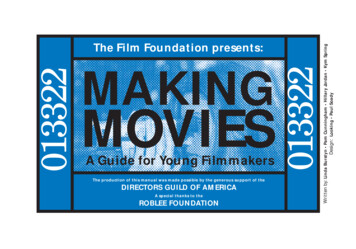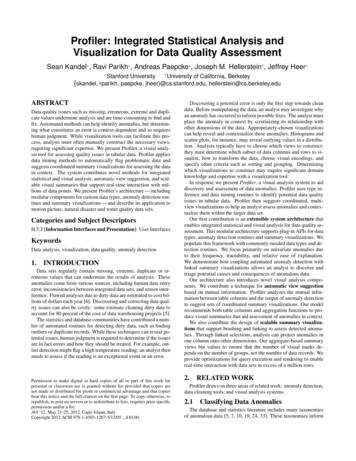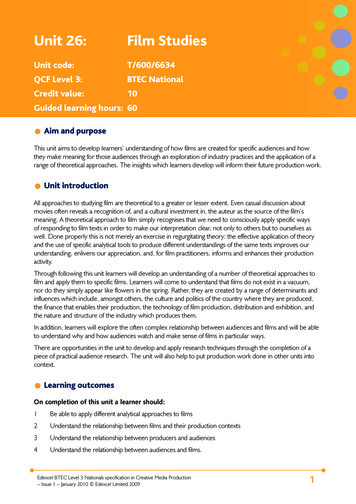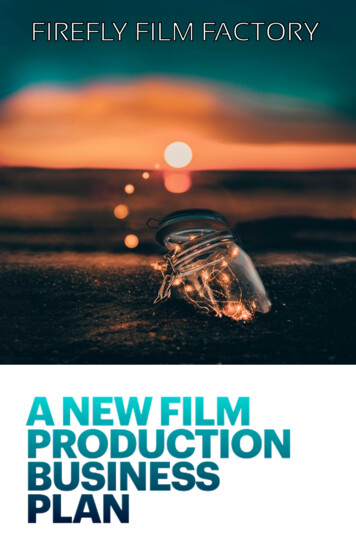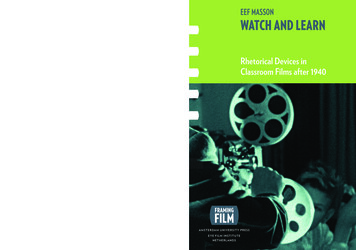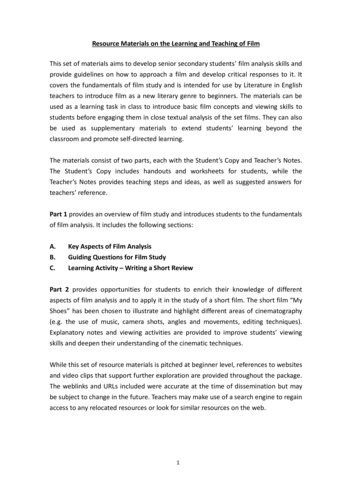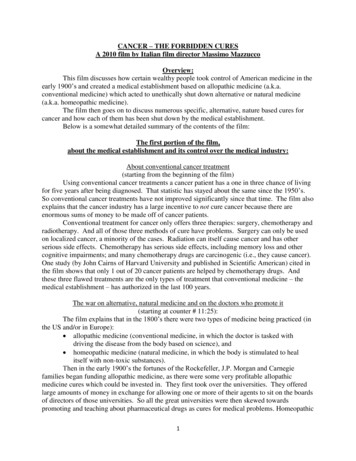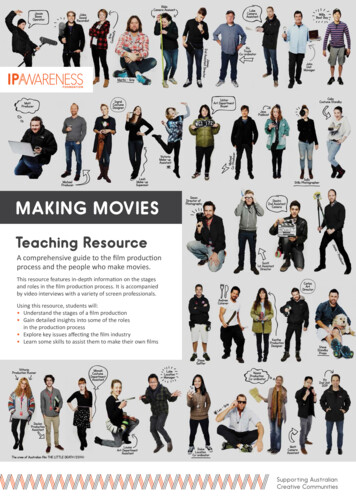
Transcription
MAKING MOVIESTeaching ResourceA comprehensive guide to the film productionprocess and the people who make movies.This resource features in-depth information on the stagesand roles in the film production process. It is accompaniedby video interviews with a variety of screen professionals.Using this resource, students will: Understand the stages of a film production Gain detailed insights into some of the rolesin the production process Explore key issues affecting the film industry Learn some skills to assist them to make their own films
ContentsChapter 1: Film Production stages . . . . . . . . . . . . . . . . . . . . . . . . . . . . . . . . . . . . . . . . . . . . . . . . . . . . . . . . . . . . . 03Development . . . . . . . . . . . . . . . . . . . . . . . . . . . . . . . . . . . . . . . . . . . . . . . . . . . . . . . . . . . . . . . . . . . . . . . . . . . . . . . . . . . . . . . . . . . . . . 04 Getting the rights. . . . . . . . . . . . . . . . . . . . . . . . . . . . . . . . . . . . . . . . . . . . . . . . . . . . . . . . . . . . . . . . . . . . . . . . . . . . . . . . . . . . . . . . . . . 05 The creative team. . . . . . . . . . . . . . . . . . . . . . . . . . . . . . . . . . . . . . . . . . . . . . . . . . . . . . . . . . . . . . . . . . . . . . . . . . . . . . . . . . . . . . . . . . . 06 Lots of expenses, little income. . . . . . . . . . . . . . . . . . . . . . . . . . . . . . . . . . . . . . . . . . . . . . . . . . . . . . . . . . . . . . . . . . . . . . . . . . . . . . . 08Pre-Production. . . . . . . . . . . . . . . . . . . . . . . . . . . . . . . . . . . . . . . . . . . . . . . . . . . . . . . . . . . . . . . . . . . . . . . . . . . . . . . . . . . . . . . . . . . . . 09 The start . . . . . . . . . . . . . . . . . . . . . . . . . . . . . . . . . . . . . . . . . . . . . . . . . . . . . . . . . . . . . . . . . . . . . . . . . . . . . . . . . . . . . . . . . . . . . . . . . . 09 The middle . . . . . . . . . . . . . . . . . . . . . . . . . . . . . . . . . . . . . . . . . . . . . . . . . . . . . . . . . . . . . . . . . . . . . . . . . . . . . . . . . . . . . . . . . . . . . . . . 10 The final weeks. . . . . . . . . . . . . . . . . . . . . . . . . . . . . . . . . . . . . . . . . . . . . . . . . . . . . . . . . . . . . . . . . . . . . . . . . . . . . . . . . . . . . . . . . . . . . 11Production . . . . . . . . . . . . . . . . . . . . . . . . . . . . . . . . . . . . . . . . . . . . . . . . . . . . . . . . . . . . . . . . . . . . . . . . . . . . . . . . . . . . . . . . . . . . . . . . 12Post-Production . . . . . . . . . . . . . . . . . . . . . . . . . . . . . . . . . . . . . . . . . . . . . . . . . . . . . . . . . . . . . . . . . . . . . . . . . . . . . . . . . . . . . . . . . . . . 16 Editing. . . . . . . . . . . . . . . . . . . . . . . . . . . . . . . . . . . . . . . . . . . . . . . . . . . . . . . . . . . . . . . . . . . . . . . . . . . . . . . . . . . . . . . . . . . . . . . . . . . . 16 Visual effects, titles and colour grading . . . . . . . . . . . . . . . . . . . . . . . . . . . . . . . . . . . . . . . . . . . . . . . . . . . . . . . . . . . . . . . . . . . . . . . . . 17 Sound . . . . . . . . . . . . . . . . . . . . . . . . . . . . . . . . . . . . . . . . . . . . . . . . . . . . . . . . . . . . . . . . . . . . . . . . . . . . . . . . . . . . . . . . . . . . . . . . . . . . 18 Music. . . . . . . . . . . . . . . . . . . . . . . . . . . . . . . . . . . . . . . . . . . . . . . . . . . . . . . . . . . . . . . . . . . . . . . . . . . . . . . . . . . . . . . . . . . . . . . . . . . . . 19Distribution and exhibition . . . . . . . . . . . . . . . . . . . . . . . . . . . . . . . . . . . . . . . . . . . . . . . . . . . . . . . . . . . . . . . . . . . . . . . . . . . . . . . . . . . 20 What does distribution involve?. . . . . . . . . . . . . . . . . . . . . . . . . . . . . . . . . . . . . . . . . . . . . . . . . . . . . . . . . . . . . . . . . . . . . . . . . . . . . . . 21 What is exhibition?. . . . . . . . . . . . . . . . . . . . . . . . . . . . . . . . . . . . . . . . . . . . . . . . . . . . . . . . . . . . . . . . . . . . . . . . . . . . . . . . . . . . . . . . . . 22 Staff who work in exhibition . . . . . . . . . . . . . . . . . . . . . . . . . . . . . . . . . . . . . . . . . . . . . . . . . . . . . . . . . . . . . . . . . . . . . . . . . . . . . . . . . . 22Chapter 2: Film production roles . . . . . . . . . . . . . . . . . . . . . . . . . . . . . . . . . . . . . . . . . . . . . . . . . . . . . . . . . . . . . . 24 Producer . . . . . . . . . . . . . . . . . . . . . . . . . . . . . . . . . . . . . . . . . . . . . . . . . . . . . . . . . . . . . . . . . . . . . . . . . . . . . . . . . . . . . . . . . . . . . . . . . . 26Production manager. . . . . . . . . . . . . . . . . . . . . . . . . . . . . . . . . . . . . . . . . . . . . . . . . . . . . . . . . . . . . . . . . . . . . . . . . . . . . . . . . . . . . . . . . 27Production designer. . . . . . . . . . . . . . . . . . . . . . . . . . . . . . . . . . . . . . . . . . . . . . . . . . . . . . . . . . . . . . . . . . . . . . . . . . . . . . . . . . . . . . . . . 29Assistant director. . . . . . . . . . . . . . . . . . . . . . . . . . . . . . . . . . . . . . . . . . . . . . . . . . . . . . . . . . . . . . . . . . . . . . . . . . . . . . . . . . . . . . . . . . . 31Production runner . . . . . . . . . . . . . . . . . . . . . . . . . . . . . . . . . . . . . . . . . . . . . . . . . . . . . . . . . . . . . . . . . . . . . . . . . . . . . . . . . . . . . . . . . . 32Camera assistant. . . . . . . . . . . . . . . . . . . . . . . . . . . . . . . . . . . . . . . . . . . . . . . . . . . . . . . . . . . . . . . . . . . . . . . . . . . . . . . . . . . . . . . . . . . . 33Hair and makeup artist. . . . . . . . . . . . . . . . . . . . . . . . . . . . . . . . . . . . . . . . . . . . . . . . . . . . . . . . . . . . . . . . . . . . . . . . . . . . . . . . . . . . . . . 34Vehicle supervisor . . . . . . . . . . . . . . . . . . . . . . . . . . . . . . . . . . . . . . . . . . . . . . . . . . . . . . . . . . . . . . . . . . . . . . . . . . . . . . . . . . . . . . . . . . 36Stunt performer. . . . . . . . . . . . . . . . . . . . . . . . . . . . . . . . . . . . . . . . . . . . . . . . . . . . . . . . . . . . . . . . . . . . . . . . . . . . . . . . . . . . . . . . . . . . 37Editor. . . . . . . . . . . . . . . . . . . . . . . . . . . . . . . . . . . . . . . . . . . . . . . . . . . . . . . . . . . . . . . . . . . . . . . . . . . . . . . . . . . . . . . . . . . . . . . . . . . . . 39Music composer. . . . . . . . . . . . . . . . . . . . . . . . . . . . . . . . . . . . . . . . . . . . . . . . . . . . . . . . . . . . . . . . . . . . . . . . . . . . . . . . . . . . . . . . . . . . 40Visual effects supervisor . . . . . . . . . . . . . . . . . . . . . . . . . . . . . . . . . . . . . . . . . . . . . . . . . . . . . . . . . . . . . . . . . . . . . . . . . . . . . . . . . . . . . 41Distribution executive . . . . . . . . . . . . . . . . . . . . . . . . . . . . . . . . . . . . . . . . . . . . . . . . . . . . . . . . . . . . . . . . . . . . . . . . . . . . . . . . . . . . . . . 43Marketing manager . . . . . . . . . . . . . . . . . . . . . . . . . . . . . . . . . . . . . . . . . . . . . . . . . . . . . . . . . . . . . . . . . . . . . . . . . . . . . . . . . . . . . . . . . 45Film programmer . . . . . . . . . . . . . . . . . . . . . . . . . . . . . . . . . . . . . . . . . . . . . . . . . . . . . . . . . . . . . . . . . . . . . . . . . . . . . . . . . . . . . . . . . . . 46Chapter 3: Industry issues. . . . . . . . . . . . . . . . . . . . . . . . . . . . . . . . . . . . . . . . . . . . . . . . . . . . . . . . . . . . . . . . . . . . 48 Piracy. . . . . . . . . . . . . . . . . . . . . . . . . . . . . . . . . . . . . . . . . . . . . . . . . . . . . . . . . . . . . . . . . . . . . . . . . . . . . . . . . . . . . . . . . . . . . . . . . . . . . 50Technology . . . . . . . . . . . . . . . . . . . . . . . . . . . . . . . . . . . . . . . . . . . . . . . . . . . . . . . . . . . . . . . . . . . . . . . . . . . . . . . . . . . . . . . . . . . . . . . . 51Finance . . . . . . . . . . . . . . . . . . . . . . . . . . . . . . . . . . . . . . . . . . . . . . . . . . . . . . . . . . . . . . . . . . . . . . . . . . . . . . . . . . . . . . . . . . . . . . . . . . . 53Sustainable production practices . . . . . . . . . . . . . . . . . . . . . . . . . . . . . . . . . . . . . . . . . . . . . . . . . . . . . . . . . . . . . . . . . . . . . . . . . . . . . . 55Chapter 4: Filmmaking. . . . . . . . . . . . . . . . . . . . . . . . . . . . . . . . . . . . . . . . . . . . . . . . . . . . . . . . . . . . . . . . . . . . . . . 57 Ideas for short films. . . . . . . . . . . . . . . . . . . . . . . . . . . . . . . . . . . . . . . . . . . . . . . . . . . . . . . . . . . . . . . . . . . . . . . . . . . . . . . . . . . . . . . . . 58 Ideas for documentaries . . . . . . . . . . . . . . . . . . . . . . . . . . . . . . . . . . . . . . . . . . . . . . . . . . . . . . . . . . . . . . . . . . . . . . . . . . . . . . . . . . . . . 59Developing your story . . . . . . . . . . . . . . . . . . . . . . . . . . . . . . . . . . . . . . . . . . . . . . . . . . . . . . . . . . . . . . . . . . . . . . . . . . . . . . . . . . . . . . . 60The three act structure . . . . . . . . . . . . . . . . . . . . . . . . . . . . . . . . . . . . . . . . . . . . . . . . . . . . . . . . . . . . . . . . . . . . . . . . . . . . . . . . . . . . . . 61Writing a screenplay. . . . . . . . . . . . . . . . . . . . . . . . . . . . . . . . . . . . . . . . . . . . . . . . . . . . . . . . . . . . . . . . . . . . . . . . . . . . . . . . . . . . . . . . . 61Storyboards. . . . . . . . . . . . . . . . . . . . . . . . . . . . . . . . . . . . . . . . . . . . . . . . . . . . . . . . . . . . . . . . . . . . . . . . . . . . . . . . . . . . . . . . . . . . . . . . 63Production tips. . . . . . . . . . . . . . . . . . . . . . . . . . . . . . . . . . . . . . . . . . . . . . . . . . . . . . . . . . . . . . . . . . . . . . . . . . . . . . . . . . . . . . . . . . . . . 65Post-production tips. . . . . . . . . . . . . . . . . . . . . . . . . . . . . . . . . . . . . . . . . . . . . . . . . . . . . . . . . . . . . . . . . . . . . . . . . . . . . . . . . . . . . . . . . 66Glossary . . . . . . . . . . . . . . . . . . . . . . . . . . . . . . . . . . . . . . . . . . . . . . . . . . . . . . . . . . . . . . . . . . . . . . . . . . . . . . . . . . . . . 67Links . . . . . . . . . . . . . . . . . . . . . . . . . . . . . . . . . . . . . . . . . . . . . . . . . . . . . . . . . . . . . . . . . . . . . . . . . . . . . . . . . . . . . . . . 70Making Movies video links at a glance. . . . . . . . . . . . . . . . . . . . . . . . . . . . . . . . . . . . . . . . . . . . . . . . . . . . . . . . . . . . . 71Acknowledgements. . . . . . . . . . . . . . . . . . . . . . . . . . . . . . . . . . . . . . . . . . . . . . . . . . . . . . . . . . . . . . . . . . . . . . . . . . . . 73
CHAPTER ONEProduction StagesIn this chapter students will learn about the stages in the film production process: Development: From an idea to a script,to the raising of finance for a film Pre-Production: The intricate planningand preparation for production Production/Principal Photography: The complex collaborative process of shooting Post-Production: The layers of activityto finesse and finish a film Distribution & Exhibition: Getting a filmto an audience and getting audiences to filmsIP Awareness Making MoviesPage 3
ut fugitall seenenistherem.longEt apelist ofnemperronames atmatheperuptatur?end of a movieOvitibusor aidTVquaeshowconsecusabutvoloresthowmucheaquametdo we knowporporeperumabout the hundredsunt ea everumof peoplesimewhoconetcontributefuga. Cuptasitto films?eWe’ve all seen the long list of names at the end of a movie ora TV show – these are the dozens or sometimes hundreds ofpeople who have contributed to the making of that film andthe “credit list” is an acknowledgement of their contribution.Content has become quite abundant and it’s easy toforget how complex it is to conceive, develop, finance andproduce a film or TV show. The media image of the industry- a seemingly constant flow of exciting award ceremonies,premieres and events attended by glamorous, wealthy actors- often overshadows the reality of the uncertainty of theprofession, the scarce freelance nature of employment andthe many years of hard work required to make every filmand TV program.Making a film or TV program can roughly be dividedinto six stages: development pre-production production (sometimes calledprincipal photography) post-production distribution exhibitionWriter, director and actress Matilda Brown talks aboutthe stages of film production. Click here to access a shortvideo interview.This resource provides an understanding of the multifacetedprocess of making film: explaining each stage - from an ideato a cinema release - and exploring a few of the hundredsof jobs involved in the process.IP Awareness Making MoviesPage 4Film production stages
DevelopmentDevelopmentUr,ut fugit enisis rem.the processEt ape nemperroof gettingmafromperuptatur?an originalOvitibusstory to idthequae consecusavolorestpointwhereeaquameta film orporporeperumTV project is readyunt eaforeverumfinancingsimeandconetproduction.fuga. Cuptasit eThis stage in the filmmaking process will take, on average,three to four years. In some cases, it has taken a lot longer. Ittook ten years for director Scott Hicks to turn an idea he readin a newspaper article into the Academy Award -winningfilm Shine.Movies originate from many sources. Some start with anoriginal idea by a writer who spends years, often unpaid,getting a script to the stage where a producer agrees to comeon board to move the project forward. The Rocket originatedthis way when writer-director Kim Mordaunt developed thescript with producer Sylvia Wilczynski.Filmmakers can find inspiration for their stories in a range ofdifferent places - including real life stories (Shine, 1996), books(Red Dog, 2011), stage plays or musicals (The Sapphires, 2012),comics (Man of Steel, 2013), theme park rides (Pirates of theCaribbean: The Curse of the Black Pearl, 2003) or even toys(The Lego Movie, 2014).As the script progresses, a development team starts to form.This usually consists of the writer, a director, and one or moreproducers. They will need to have a strong belief in their ideabecause they have to make dozens of other people believe init to finance and produce the movie. Those investors in turnwill need to believe that the film can attract audiencesin their tens and hundreds of thousands and more.IP Awareness Making Movies“Not one person in the entire motion picture field knowsfor a certainty what's going to work,” wrote screenwriterWilliam Goldman in Adventures of the Screen Trade.“Every time out it's a guess and, if you're lucky, an educatedone.” This is one of the key issues in the film industry –even though a great deal of money needs to be spent tomake a film, there are many variables that will affect itssuccess – from the script, the cast and the director to themusic, the chemistry between actors and many other factors.It is difficult to predict how a film will turn out, making filmproduction a high-risk industry.Getting the rightsEvery published, performed or created work is coveredby copyright that belongs to the original creator or theowner of the work – books, newspaper articles, comic strips,plays, musicals, songs, theme park rides. The producer mustacquire the rights to produce the movie by paying a fee tothe original creator.Page 5Development
Producer Nicole O’Donohue at work on the development of her next film.Chain of title is the series of links that establishes the legalright of the producer to make the movie, and to distribute it.Here’s what happened with the film Rabbit Proof Fence: Christine Olsen, a scriptwriter, reads Doris PilkingtonGarimara’s book about her mother’s childhoodexperiences and contacts the publishers, UQP, to applyfor the film rights. She is advised that all interestedparties must submit 3-4 pages on how they see thefilm as part of their application. Christine wants to meet Doris but because of Doris’sbusy schedule the only way they can meet is ifChristine drives her to the airport. Doris supportsChristine’s application to write a screenplay basedon her book. Christine signs an agreement with thepublishers to write the screenplay, taking out an“option” to make a film from the book. Having written the screenplay, Christine rings DirectorPhillip Noyce in the middle of the night in LA, whichmakes him direct his office to have nothing to do withher! His office reads the script and likes it, but it takesthem months to convince Phillip to read it. Phillip and Christine co-produce the film. ExecutiveProducers are brought in to raise the finance for themovie based on Christine’s script. The strength of the original story and Phillip Noyce’sstrong track record enables the executive producers toraise the finance and Phillip and Christine co-producethe movie, with Phillip directing. Throughout the process, Doris and Christine hold ontotheir copyright - Doris for the book and Christine forthe original script - which allows them to receive somepayment for their work when the film is made.With options signed, the producer prepares a campaignto put the movie together, working simultaneously on anumber of fronts.The script is the blueprint of the story, based on the originalwork or idea, and is usually between 90 – 120 pages long.It describes every scene in the film. Eight or ten drafts ofthe script will be written as development proceeds. A singledraft can take weeks or months; it’s incredibly difficult toget a script right – finding the right tone, pace, charactermotivation and development, story arc and dialogue as wellas creating tension, humour or mood. This is a costly processthat involves high levels of skill and lots of time.Writing teams for US studio films tend to be biggerthan those for Australian films. A US script might havecontributions from many writers who have particular skills,such as someone skilled in action scenes or another whowrites great dialogue. Experts in the film’s subject mattermay also be involved, such as a doctor for any medicalinformation or an historian for period dramas.The creative teamAt this stage, the producer will start to find the keycreative team such as:Time is of the essence. The initial agreement – and option fee– will usually allow the producer three years to raise financefor the movie. This puts pressure on the producer to exercisethe movie rights within the time frame, or face additional feesto renew the agreement or lose the option – making all theirIP Awareness Making Movieswork in those three years worthless. Scripts generally needto be reasonably advanced before investors will get involved. A director suited to the subject of the film, and witha good track record and reputation. A distributor who is in tune with the movie, and hassuccessfully handled the release of similar moviesthroughout Australia. Actors who suit the roles and whose previous filmshave attracted audiences and good box office revenue.Page 6Development
If elements like music, design or cinematography are integralto the success of this particular film, the producer may alsotry to secure the right people for these roles as they couldassist in making the film attractive to potential investors.The sales document or prospectus is designed to attractinvestors who will pay for the film to be made. It contains anoutline of the project and explains why it will be a successfulmovie. It will list the key creative crew and possible castattached to the project and each individual’s filmography.This document will include a detailed financial plan showinghow much the film will cost and where the money willcome from.A medium-budget Australian movie, considered to be in the 6 million to 10 million range, usually involves a numberof investors, such as: An Australian distributor who will guarantee the moviea release in cinemas. An overseas sales agent who will sell the movieworldwide to overseas distributors. Federal and state government screen funding agencies. A TV or cable network that will screen the movie afterits cinema and DVD release. Private investors who may agree to support the film for arange of reasons but always in the hope of good returns.Once the script is finalised, a first assistant director isemployed to prepare a preliminary shooting schedule.This document “breaks down” all the scenes in the scriptand re-arranges them into what will be shot on eachseparate shooting day. Films are never shot in script order- the schedule will try to maximise the use of locations andcast so that the crew doesn’t have to spend more time thannecessary packing up, moving locations and setting up.The schedule notes all the elements that will be neededfor each day, such as sets, locations, cast, extras, picturevehicles, animals and special equipment.The producer then employs an experienced productionmanager for several weeks, to prepare a preliminary budgetbased on the script and schedule. The budget identifies ingreat detail all the costs of the film. This shows the investorsthat the script can be produced for the amount of money theproducer is intending to raise.CREATING A BUDGET Every element of the script has to be budgeted. Here’s an example.Mrs Poulos alights from a bus, which drives off. Her neighbour, youngLiv, also gets off at the same stop, and sees that Mrs Poulos is havingtrouble carrying her shopping. She’s broken her ankle skiing, she’swearing a moon boot, and she’s using a walking stick. Liv is going tohelp her.For this screenplay, the budget would reflect fees for cast and crew, and also, for that day, the cost of: bus and driver hirea traffic plan to ensure the cast and crew are safe, as well as normal traffic on the streetlocal council fees for processing permission to filmtraffic controllers and equipmenthire of the moon boot and walking stickhire or purchase of costumes and propsparking for the trucks and for crew carscatering and portable toiletscaravans so the actors can change into their costumes and be made up.IP Awareness Making MoviesPage 7Development
Lots of expenses, little income.At this point, a great deal of time and money has been spent: to acquire the rights to make the original work into amovie, plus the cost of lawyers to secure these rights, to pay the writers for each script draft, to pay the first assistant director and theproduction manager, to create the materials to promote and market thefilm to investors, key creatives and potential actors,including documents and perhaps a teaser trailer to run a production office.Research from 2007 into six Australian feature films showedtheir average cost of development was 258,002.During this long development period the producer is oftenunpaid, and the movie’s development may be interruptedwhen he/she has to accept other work to pay for normaldaily expenses, as well as the cost of keeping thedevelopment process on track.Finally, months or maybe years later, all is agreed, all isin place, and the many parties involved can sign the PIA(Production Investment Agreement) - a huge pile ofcontracts including: agreements that confirm the chain of title for therights and the script agreement that confirms the involvement of directorand contracts with lead cast contracts that confirm which financing body willprovide how much money and on which dates, and– very importantly – how the profits from the moviewill be shared among the producer and the investorsonce it has been released.When all the signatures are on the page, it’s time to startpre-production.The producer may have to attend a number of internationalfilm markets, such as Cannes, to secure investment frominternational partners. Travel may also be required topersuade the international agents for well-known actorsthat their clients will benefit from appearing in the movie,at a price the producer can afford.Troy Lum, managing director of Hopscotch, perusing a screenplay.IP Awareness Making MoviesPage 8Development
Pre-ProductionOnceUr,ut fugita filmenishasrem.beenEt financed,ape nemperropre-productionma peruptatur?starts. PlanningOvitibus theid quaeshootconsecusavolorestisa processeaquametwhich involvesporporeperuma numberuntofeadepartmentseverum simeworkingconet collaboratively.fuga. Cuptasit eThe startAs the funding for a film is secured, the producer startsto work with the heads of department, such as thecinematographer, who leads the camera department andthe designer, who heads up the art department, to finalisewho will be involved in their teams.Filmmaking is primarily a freelance industry where individualsare employed for the length of the project only, sometimesonly a matter of months. Many crew members will havehad a gap of weeks or even months between productions.Sometimes they work on commercials or TV shows, butsometimes they need to take other jobs - in cafes, drivingcabs or doing office work.Early in pre-production a casting agent is also employedto start finding actors for the supporting roles. While thisis happening, the writers and directors polish the final draftof the screenplay. The production manager finds officespace and equips it with furniture, phones and internet.The first assistant director refines the shooting scheduleto work around the availability of the lead actors andlocations. Meanwhile the location manager is scoutingfor locations and confirming their availability.The length of pre-production is related to the complexityand budget of the film. In general, pre-production is given thesame time as the shoot. A medium-budget Australian film willshoot for about ten weeks, so that will be the time allocatedto pre-production.Many of these people work with each other to weigh upthe look of a location against its cost within the budget. Theperfect location may be in a distant location, but moving anentire film crew is very expensive. Valuable shooting time islost during the move to another place because the crew andcast are paid for the time it takes to travel elsewhere. Othercosts include accommodation and travel allowances.IP Awareness Making MoviesPre-production usually begins with a production meeting,during which the director takes the team through the scriptscene by scene to communicate his or her intentions in greatdetail, and to answer the crew’s questions.Briefings with the production manager then take place forall heads of department, so each department knows howmuch money they can spend in their specific area – props,costumes, locations, camera equipment.Page 9Pre-Production
During pre-production, the production department creates all the props for the film.Auditioning and casting will occupy most of the directorand producer’s time for the next few weeks, now that thedepartments are working on their script breakdowns andcostings. They have briefed a casting director who has putout a call to local actors’ agents about the roles available.The casting director has made a list of recommended actorswhose showreels will be viewed online.A pre-production schedule is prepared by the productionmanager and the first assistant director, to cover the next tenweeks. It reflects what everybody needs to do, and when. Asthe director’s input is required in so many departments, theschedule must reflect all meetings necessary for decisionsand progress to be made. It is issued on paper to everybody,and reproduced on a big whiteboard in the production officefor general reference as well. Being a schedule, it will change,and all changes have to be communicated promptly toeveryone involved.The middleThe early weeks of pre-production are busy for everydepartment. Each week everyone meets to go throughthe script and cover any changes, discuss the schedule,and then work through every shooting day in detail toresolve questions and issues.Here’s an overview of what some key departments willdo in these weeks:Production department Keeps up the flow of communication to all membersof the team: contact lists, schedules, scriptamendments, meetings, location surveys Identifies and negotiates fees and issues contractsfor all crew and cast members Books flights and accommodation, equipment,vehicles, equipment trucks and cast caravans Sets up workplace safety systems and arrangesthe production’s insurances Tracks expenditure and projected expenditureLocations Find and confirm the locations with the productiondesigner and director Arrange permission for any work to be done,for example painting a room Arrange council, police and traffic permissionsfor exterior locationsThe heads of departments start to engage their ownteams to work on the project according to their suitabilityand availability.“The heads of departments start to engage their own teams towork on the project according to their suitability and availability.”IP Awareness Making MoviesPage 10Pre-Production
CASE STUDY: THE HOBBITDuring the production of The Hobbit, director Peter Jackson mainta
This stage in the filmmaking process will take, on average, three to four years. In some cases, it has taken a lot longer. It took ten years for director Scott Hicks to turn an idea he read in a newspaper article into the Academy Award -winning film Shine. Movies originate from many sources. Some start with an

